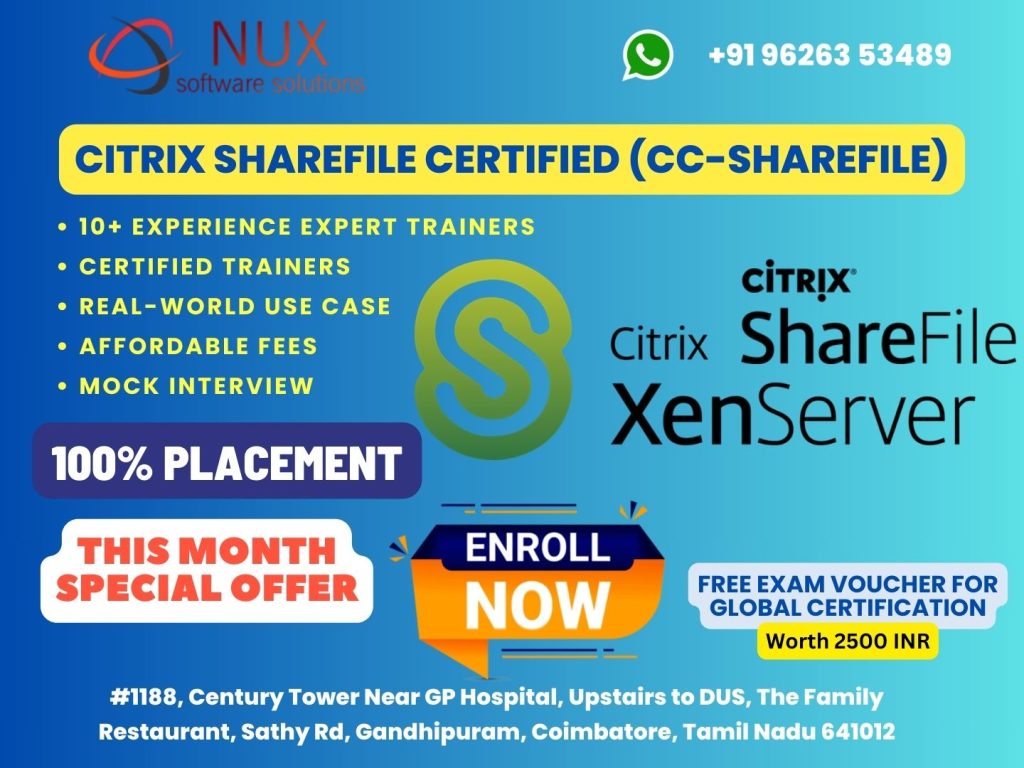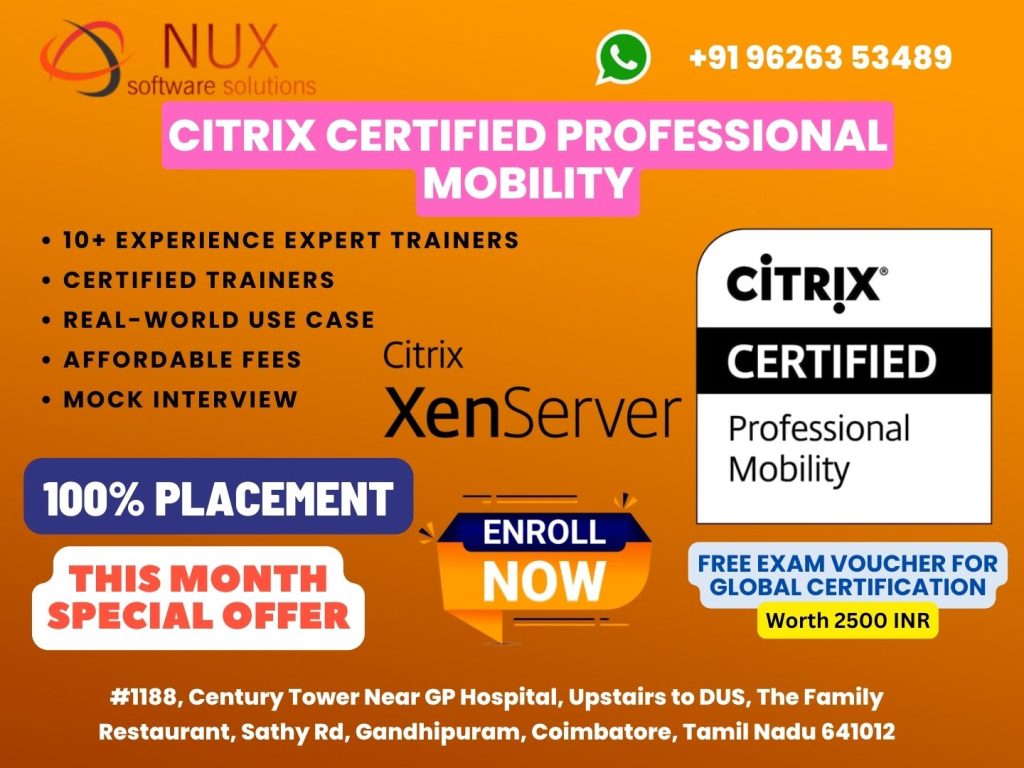Citrix Virtual Apps and Desktops 7 Assessment, Design and Advanced Configurations CCE-V

Citrix Virtual Apps and Desktops 7 Assessment, Design, and Advanced Configurations (CCE-V) Training in Coimbatore
Course Overview
The Citrix Certified Expert – Virtualization (CCE-V) training is Citrix’s most advanced-level course, designed for IT professionals who are responsible for designing complex Citrix Virtual Apps and Desktops environments. This course emphasizes the assessment, planning, and advanced configuration skills required to deliver scalable, secure, and high-performing virtualization solutions across enterprise infrastructures.
At Linux Training Center in Coimbatore, we offer comprehensive CCE-V training for architects, senior engineers, and consultants who are looking to master the complete lifecycle of Citrix Virtual Apps and Desktops 7—from evaluation and design to optimization and troubleshooting.
The course is packed with deep technical concepts, real-world challenges, and architectural decision-making practices that mirror the demands of large-scale production environments.
Who Should Enroll?
Experienced Citrix engineers and architects
IT professionals managing complex virtual desktop environments
System administrators planning to design multi-site Citrix deployments
Candidates holding CCP-V certification and preparing for the CCE-V exam
IT consultants and technical leads responsible for Citrix project delivery
This course is ideal for those already proficient in daily administration of Citrix environments and ready to move into architectural and strategic roles.
What You Will Learn
Participants will gain hands-on experience in the design and deployment of Citrix Virtual Apps and Desktops infrastructure. Key learning modules include:
Performing comprehensive environmental assessments to gather technical and business requirements
Designing Citrix Virtual Apps and Desktops environments for scalability, redundancy, and high availability
Selecting the appropriate hypervisor, hosting, provisioning, and access strategy based on use cases
Applying best practices in user layer design including profile management and application delivery
Creating a resilient architecture using StoreFront, Citrix Gateway, Delivery Controllers, and SQL
Developing detailed migration and disaster recovery strategies
Planning for cloud, hybrid, or on-premises deployments
Documenting architectural decisions and presenting Citrix designs to stakeholders
This training ensures learners are equipped to make strategic decisions and solve design-level challenges with confidence.
Why Take the CCE-V Course?
Validate your expertise as a Citrix solution architect
Master real-world design methodologies for virtual desktop infrastructure
Learn how to align Citrix environments with business needs and compliance requirements
Get recognized as a high-level Citrix consultant or technical expert
Prepare for the Citrix Certified Expert – Virtualization certification exam with confidence
Career Path and Job Roles
With CCE-V certification, professionals can step into elite roles such as:
Citrix Architect
Senior Virtualization Consultant
Cloud VDI Solutions Designer
Enterprise IT Infrastructure Specialist
Citrix Technical Project Manager
These roles often involve higher levels of responsibility, project leadership, and greater compensation.
Why Linux Training Center, Coimbatore?
Learn from Citrix-certified experts with enterprise deployment experience
Advanced training labs replicating complex multi-site environments
Practical design scenarios and case studies included in every module
Personalized mentoring for exam readiness and solution architecture planning
Flexible batch timing and remote learning options available
Trusted by professionals and enterprises across Coimbatore
Advance your Citrix career to the highest level with expert-led training at Linux Training Center. Whether you’re designing from scratch or optimizing an existing environment, this course equips you with the skills to deliver strategic solutions that scale.
Citrix Virtual Apps and Desktops 7 Assessment, Design and Advanced Configurations CCE-V Syllabus
Modules
- Determine the design decisions that should be made based on given business drivers.
- Determine how to complete the user segmentation process for a given environment.
- Determine how to categorize applications based on a scenario.
- Assess a given environment to determine the capabilities of that environment.
- Determine the appropriate endpoint type and peripherals required for a given environment.
- Determine how to appropriately deploy Citrix Workspace app based on a list of requirements.
- Determine the network connectivity and graphics requirements for a design.
- Determine the appropriate settings and configurations to make when designing an access deployment strategy for Citrix Gateway and StoreFront/Workspace.
- Determine the architectural needs of an environment when designing StoreFront stores.
- Determine access layer scalability for Citrix Gateway and StoreFront in a given environment.
- Determine how to appropriately scale the infrastructure for Virtual Delivery Agent Machines in a given environment.
- Determine how to secure the Virtual Delivery Agent Machines based on a scenario.
- Determine how to design the appropriate image provisioning strategy for a given environment.
- Determine the appropriate delivery options for Application deployment based on the analysis of the given environment.
- Determine the appropriate profile strategy to use in a given environment.
- Determine the appropriate policies to implement in a given environment.
- Determine the appropriate delivery method to recommend when designing a Site for a given environment.
- Determine the appropriate management and administration design based on given requirements.
- Determine the appropriate site design and baseline specifications to ensure performance and stability in the given environment.
- Determine the Control Layer security requirements and features necessary to secure a given environment.
- Determine the appropriate hardware or hypervisor to implement based on a given design.
- Determine the appropriate resource pool strategy for a given environment.
- Determine the appropriate hardware sizing based on a scenario.
- Determine the appropriate storage allocations to ensure optimization in a given environment.
- Determine the appropriate Datacenter configurations for network traffic in a given environment.
- Determine how to meet the security objectives and best practices for a given environment.
- Determine Multi-location architecture requirements and business considerations in a given environment.
- Determine the appropriate access configurations to recommend when designing a multi-site environment.
- Determine the appropriate Image Management requirements in a given environment.
- Determine the requirements for profiles and data in a multi-location environment.
- Determine the appropriate strategy to support printing in a multi-location solution.
- Determine how to design a site and FMA zones to ensure users have continuous access to resources in a multi-location solution.
- Determine the appropriate Disaster Recovery Strategy for a given environment.
- Determine how to recover a primary datacenter in the disaster recovery datacenter given a scenario.
Recommended Knowledge and Skills for 1Y0-403:
- Network systems Including security, implementation and administration
- Citrix methodology and best practices for analysis and design
- Core design principles
- Installing Citrix technologies associated with app and desktop virtualization
- Configuring Citrix technologies associated with app and desktop virtualization
- Administering an app and desktop virtualization environment
- Maintaining an app and desktop virtualization environment
- Backing up components of an app and desktop virtualization environment
- Updating an app and desktop virtualization environment
- Monitoring an app and desktop virtualization environment
- Creating reports for trend analysis in environments that include a Citrix app and desktop virtualization solution
- Troubleshooting environments that include a Citrix app and desktop virtualization solution
- Cloud concepts such as private, public, and hybrid clouds
- Storage concepts
Recommended Product Experience for 1Y0-403:
- Citrix Virtual Apps 7 (Build 1912 LTSR)
- Citrix Virtual Desktops 7 (Build 1912 LTSR)
- Citrix Cloud, including
- Citrix Virtual Apps and Desktops Service
- Citrix Gateway Service
- Citrix Hypervisor 8.0
- Citrix App Layering
- Citrix Workspace Environment Management
- Citrix Provisioning 7 (Build 1912 LTSR)
- Citrix ADC 13 Citrix Profile Management
- Citrix Workspace App
- Microsoft Active Directory Services
- Microsoft Windows Server 2019
- Troubleshooting tools
- Microsoft SQL Server 2017
- Microsoft Active Directory Domain Services (ADDS)
- Microsoft Active Directory Certificate Authority (ADCA)
- Microsoft Internet Information Services (IIS)
- Microsoft Distributed File System (DFS)
- Dynamic Host Configuration Protocol (DHCP)
- Domain Name System (DNS)



